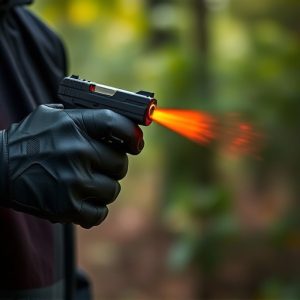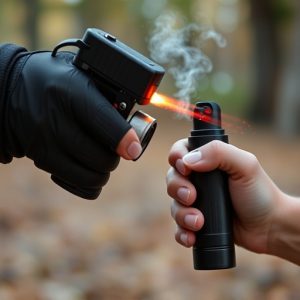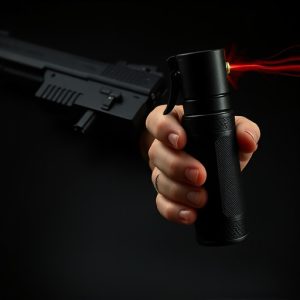Mastering Pepper Spray Defense: Ingredients, Choice, and Safety
Anti-assault pepper spray, a powerful non-lethal self-defense tool, uses capsaicin (oleoresin capsic…….
Anti-assault pepper spray, a powerful non-lethal self-defense tool, uses capsaicin (oleoresin capsicum or OC) and other additives, with concentrations up to 25%, to incapacitate attackers. The legality of pepper spray varies by jurisdiction, so understanding local regulations is crucial. The top 5 strongest legal pepper spray ingredients include OC, piperine, capsaicin (3-5 million Scoville Heat Units), and piperidene, offering maximum effectiveness against threats. Selecting a spray requires considering ingredients, potency, reach, duration, and local laws. Proper application techniques and safety precautions, such as aiming for the attacker's face and adhering to legal restrictions, ensure optimal protection while using these powerful ingredients as a last resort.
“Staying safe in an uncertain world is paramount, and anti-assault pepper spray stands as a powerful personal defense tool. This comprehensive guide explores everything you need to know about these potent self-defense mechanisms. From understanding the fundamentals of how they work to deciphering legal restrictions that govern their use, we delve into the top 5 strongest legal pepper spray ingredients currently available. Learn essential factors for choosing the right defense option and discover application techniques and safety precautions to ensure optimal protection.”
- Understanding Anti-Assault Pepper Spray: A Comprehensive Overview
- Deciphering Legal Restrictions: What Makes a Pepper Spray Legal?
- Top 5 Strongest Legal Pepper Spray Ingredients Explained
- Choosing the Right Defense Tool: Factors to Consider
- Application Techniques and Safety Precautions for Optimal Protection
Understanding Anti-Assault Pepper Spray: A Comprehensive Overview
Anti-assault pepper spray is a non-lethal self-defense tool designed to temporarily incapacitate an attacker, providing users with precious time to escape potentially dangerous situations. This type of spray contains capsaicin, the active ingredient found in chili peppers, which irritates the eyes, nose, and respiratory system when inhaled.
The effectiveness of anti-assault pepper spray lies in its powerful ingredients, often referred to as the strongest legal pepper spray components available. These include oleoresin capsicum (OC), a concentrated form of capsaicin, and various other additives that enhance its performance. The concentration of OC can range from 10% to 25%, ensuring maximum impact while adhering to legal restrictions on occlusion and permanent damage prevention.
Deciphering Legal Restrictions: What Makes a Pepper Spray Legal?
When considering an anti-assault pepper spray as a personal defense tool, understanding legal restrictions is paramount. The legality of pepper spray varies significantly from one jurisdiction to another. What constitutes a legal pepper spray is determined by local laws and regulations, which can be complex and often vary based on ingredients, concentration, and intended use.
The key to deciphering these restrictions lies in the specific chemical compounds used. Strongest Legal Pepper Spray Ingredients typically include capsaicin, the active ingredient responsible for the burning sensation associated with chili peppers. However, not all capsaicin-based sprays are created equal; legal limits on capsaicin concentration and other additives ensure that pepper spray remains classified as a legal defense tool. Staying informed about local laws is crucial to ensuring compliance and effective personal protection.
Top 5 Strongest Legal Pepper Spray Ingredients Explained
When it comes to choosing the top 5 strongest legal pepper spray ingredients, several key components stand out for their effectiveness and reliability in self-defense scenarios. First on the list is oleoresin capsicum (OC), naturally derived from chili peppers. OC is often considered the gold standard with a Scoville Heat Unit (SHU) rating of over 1 million. Next, we have piperine, a potent compound extracted from black peppercorns, known for its high SHU and ability to enhance OC’s effects.
Another powerful ingredient is capsaicin, responsible for the burning sensation associated with chili peppers. With an SHU ranging from 3 million to 5 million, capsaicin can incapacitate an assailant temporarily. Additionally, piperidene, a lesser-known but potent compound, offers a high SHU and excellent longevity, making it ideal for extended protection. Lastly, the combination of these ingredients in modern pepper spray formulations ensures maximum effectiveness against potential threats, providing users with peace of mind and a powerful defense tool.
Choosing the Right Defense Tool: Factors to Consider
When selecting an anti-assault pepper spray as your personal defense tool, understanding its ingredients and potency is key to ensuring maximum effectiveness in a dangerous situation. Look for products containing capsaicin, often recognized as the active ingredient in chili peppers, which is known for its powerful irritation of eyes, skin, and respiratory tracts. The strength of legal pepper spray ingredients varies widely; higher concentrations, typically measured in milligrams per ounce (mg/oz), offer greater durability against potential attackers.
Factors to consider include not only the potency but also the reach and duration of the spray’s effects. You’ll want a product with a good range, allowing for safe distance from an aggressor, and long-lasting effects to provide time to escape. Additionally, familiarity with local laws regarding pepper spray ownership and usage is essential; some regions have specific restrictions on concentration levels and the types of individuals permitted to carry them. Choosing a defense tool that aligns with these legal boundaries ensures you’re prepared while staying within the law.
Application Techniques and Safety Precautions for Optimal Protection
When using an anti-assault pepper spray for defense, understanding application techniques and safety precautions is crucial for optimal protection. For maximum effectiveness, it’s essential to aim for the attacker’s eyes, nose, and mouth. This targeted approach ensures that even a small amount of the strongest legal pepper spray ingredients can disable an assailant quickly. Practice proper technique by holding the canister at close range (around 3-4 inches) and spraying in short bursts, moving side to side to ensure full coverage.
Safety precautions are paramount when carrying and using pepper spray. Always store it in a safe, secure location that’s easily accessible. Keep it out of reach of children and avoid excessive use, as repeated or prolonged exposure to capsaicin, the active ingredient in pepper spray, can cause respiratory issues. Regularly inspect the canister for damage or leakage and replace it according to the manufacturer’s recommendations. Additionally, familiarize yourself with local laws regarding pepper spray usage to ensure compliance and minimize potential legal consequences.
Anti-assault pepper spray is a powerful personal defense tool, but understanding its legal aspects and choosing the right formula is crucial. The article has provided an in-depth look at the strongest legal pepper spray ingredients, highlighting their effectiveness while navigating legal restrictions. By considering factors like active ingredient concentration, usage range, and safety precautions, individuals can make informed decisions to protect themselves. Remember that knowledge and preparation are key to staying safe, and the right pepper spray could be a game-changer in unexpected situations.


